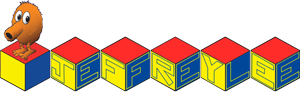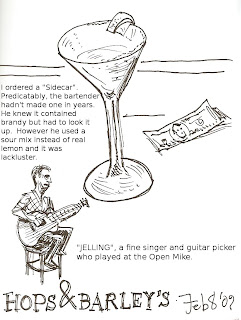I decided to employ the thistle, a symbol of Scotland, as the motif on the 12-string. After some failed attempts with other materials, I settled on thinly cut lyptus to represent the leaves of the plant. I tinted a water-based stain with food coloring to make them green, glued the pickguards to the soundboard and lacquered the body.
About 30 years ago, Mr Kopriva gave me the remnant of a 12-string mandolin, consisting of the
shell back, neck (no fingerboard) and headstock. One set of 6 tuners and the bridge and saddle were included. There was no soundboard and the nut was missing, too. I started working on it at Bob Gorney’s ( a Chicago luthier ) shop. With his assistance, I put on the fingerboard and cut the fret slots, as well as glued on a soundboard. Then, I got distracted by life and forgot about it for 25 years…

I’ve been massacring the mandolin for too many years, but I’ve seldom met another player. Whereas, guitar players are a dime
a dozen. This is perfectly reasonable because the guitar is a more versatile instrument and better suited as accompaniment when singing. Still, I think every guitar player ought to learn a second instrument. So when Mr Doman said his pal Dan, the mandolin player for “Cabin 5” would be playing at Hops & Barley’s, I was delighted to catch their performance.

As far as I know, not too many copies of this game were ever sold, but that is not very surprising. Avalon Hill was more of a hard-core specialty war game publisher. They did little, if any, mainstream advertising. Their customer base typically had little interest in a game of this sort. I believe we got one royalty check for about $400 and another for $50ish. Oh, well, it is a fun game though!
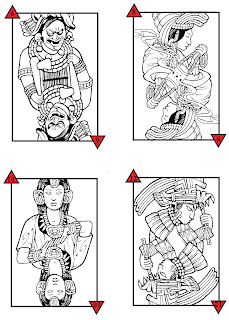 For my sources, I appropriated imagery from the archives of each broad racial group depicted. I suppose some today would object to this on several levels, but it boots not. Oh-so-cleverly the numbers of sides on each symbol increase…the circle having one (or two if you count both inside and outside), the crescent having two (or four…), &c, &c. Naturally, being playing cards, the images need to be mirrored and it was fun working that out. A little more difficult, and certainly less successful, was the lettering (not depicted in these images) for each “court card”. The object was calligraphy which read the same whether upside or downside for the words: LORD, QUEEN, PRIESTESS, WARRIOR, ASSASSIN, THIEF.
For my sources, I appropriated imagery from the archives of each broad racial group depicted. I suppose some today would object to this on several levels, but it boots not. Oh-so-cleverly the numbers of sides on each symbol increase…the circle having one (or two if you count both inside and outside), the crescent having two (or four…), &c, &c. Naturally, being playing cards, the images need to be mirrored and it was fun working that out. A little more difficult, and certainly less successful, was the lettering (not depicted in these images) for each “court card”. The object was calligraphy which read the same whether upside or downside for the words: LORD, QUEEN, PRIESTESS, WARRIOR, ASSASSIN, THIEF.
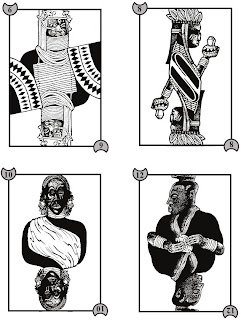 OD was published in 1985. Avalon Hill trademarked it as their “metaphysical card game” and “elemental force card game”…”A unique blend of skill and chance.” What is an od? “An od is an element of theoretical force. By bringing the ods into balance, one may reach perfection in the metaphysical world. All of life is seeking after such balance. So too is this game.” I’m not exactly sure what that means. Yes, a well-balanced life sounds like a good thing, until one starts nit-picking about what exactly is being balanced. At any rate, OD is a good game, though it would have been better if published with the original components. In what were probably cost cutting moves, two standard 6-sided dice were substituted for the original 6, 8, 10 and 12 sided dice and the number of thief cards was cut down from the initial 20 to a measly 6. The cards themselves are heavy stock but definitely not standard durable playing card stock and they are much worse for wear over the years.
OD was published in 1985. Avalon Hill trademarked it as their “metaphysical card game” and “elemental force card game”…”A unique blend of skill and chance.” What is an od? “An od is an element of theoretical force. By bringing the ods into balance, one may reach perfection in the metaphysical world. All of life is seeking after such balance. So too is this game.” I’m not exactly sure what that means. Yes, a well-balanced life sounds like a good thing, until one starts nit-picking about what exactly is being balanced. At any rate, OD is a good game, though it would have been better if published with the original components. In what were probably cost cutting moves, two standard 6-sided dice were substituted for the original 6, 8, 10 and 12 sided dice and the number of thief cards was cut down from the initial 20 to a measly 6. The cards themselves are heavy stock but definitely not standard durable playing card stock and they are much worse for wear over the years.
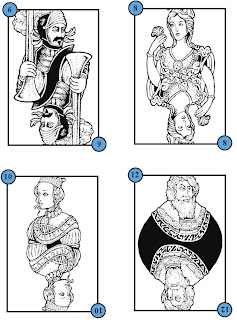 Way back when, my buddy Dave devised a card game…it was based on the number of cards in a Tarot deck and involved the use of polyhedral dice. He asked me to make illustrations for the face cards. Somehow, he managed to persuade the Avalon Hill Game Company of Baltimore, Maryland to publish the game, which is called OD. We were quite thrilled, since some of our favorite war games were published by Avalon Hill.
Way back when, my buddy Dave devised a card game…it was based on the number of cards in a Tarot deck and involved the use of polyhedral dice. He asked me to make illustrations for the face cards. Somehow, he managed to persuade the Avalon Hill Game Company of Baltimore, Maryland to publish the game, which is called OD. We were quite thrilled, since some of our favorite war games were published by Avalon Hill.
